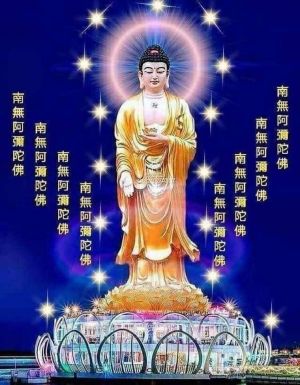Difference between revisions of "Terminology - Jōdo-shū"
| Line 1: | Line 1: | ||
[[File:1 078 n.jpg|thumb]] | [[File:1 078 n.jpg|thumb]] | ||
| + | |||
| + | |||
| + | |||
| + | |||
| + | |||
| + | |||
| + | |||
Latest revision as of 19:42, 2 April 2024
The following index was serves as a general reference for technical terms used in Jodo Shu. The index is divided into two sections, Japanese to English and English to Japanese. We have also included the Chinese characters for terms in terms which will not be readable for those without the proper operating system or language kit.
» English-Japanese Index » Japanese-English Index
For certain technical words which either originated in Indian or Chinese Buddhism or are well known to English speakers in these other languages, we have added Sanskrit (skt.) or Chinese (ch.) references.
In certain places we have also added cross references to terms which:
a) have alternate translations
- senju-nembutsu
found under: Exclusive Nembutsu or Single-Minded Recitation of the Nembutsu
b) may be referenced in various ways
-juhachigan
found under: Eighteenth Original Vow or Original Vow, Eighteenth
c) are part of a larger set of terms
-kammuryoju-kyo - Meditation Sutra
also found under: jodosanbu-kyo - Three Sutras of the Pure Land
In order to better understand the use of certain terms in every day speech, we have used capitalization for English terms in a variety of cases:
1. proper nouns (names of teachers, sutras or manuscripts, movements, sects, special ceremonies or holidays, etc.) e.g. Kyoseikai movement - kyosei-kai
2. special technical terms
a) those with capitals refer to translations of terms recommended for use in English as new words., e.g. Right Practices - shogyo
b) those terms which appear in small letters refer to
-common nouns, e.g. temple bell - kosho
-serve as general descriptive terms for the Japanese and we recommend that the Japanese term be used in everyday English speech., e.g. Obon/Urabon - summer memorial services
3. in general, all Romanized Japanese terms are in lower case. Those that are capitalized are meant to be used in daily spoken English (teachers, ceremonies)., e.g. Segaki - ancestral ceremony
Finally, concerning the style of the Japanese romanization, we have adopted a system which we hope facilitates pronunciation and understanding of the terms for those who don't speak Japanese.
1. hyphens between words indicate a general division of meaning, e.g. amida-kyo - Amida Sutra
-the meaning of "kyo" is sutra and is used with other such terms like: muryoju-kyo - Sutra of Immeasurable Life
2. a space in between words indicates a separation in pronunciation for words that might otherwise be too long and difficult to pronounce, e.g. ichimai kishomon - One Page Document
In general, we hope that the overseas Jodo Shu communities may develop their own translations of the terms through daily use, that is, certain terms like "gassho" may become new English loan words, while others like "sanjin" - "Three Minds" will be used in their translated form.
Source
[[1]]
